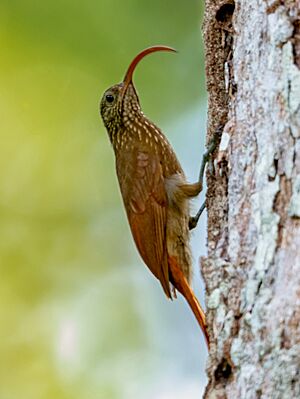Curve-billed scythebill facts for kids
Quick facts for kids Curve-billed scythebill |
|
|---|---|
 |
|
| At Manaus, Amazonas, Brazil | |
| Conservation status | |
| Scientific classification | |
| Genus: |
Campylorhamphus
|
| Species: |
procurvoides
|
The curve-billed scythebill (Campylorhamphus procurvoides) is a unique bird found in South America. It belongs to the ovenbird family called Furnariidae. You can find this bird in countries like Brazil, Colombia, Ecuador, French Guiana, Guyana, Peru, Suriname, and Venezuela.
Contents
Understanding the Curve-billed Scythebill
How Scientists Classify This Bird
Scientists who study birds, called taxonomists, sometimes have different ideas. For the curve-billed scythebill, most agree on three main types, or subspecies:
- C. p. sanus
- C. p. gyldenstolpei
- C. p. procurvoides
Some groups of scientists used to include more subspecies. However, in 2023, many agreed to split some of these into new, separate species. This shows how science is always learning new things!
What Does the Scythebill Look Like?
The curve-billed scythebill is a medium-sized bird, about 22.5 to 25 cm (9 to 10 in) long. It weighs around 30 to 38 g (1.1 to 1.3 oz). This bird is known for its very long, thin, and strongly curved bill, which looks a bit like a scythe.
Both male and female scythebills look alike. Their heads and necks are dark brown with thin, light streaks. Their backs are olive-brown to reddish-brown. The wings and tail are a bright rufous-chestnut color, which stands out.
Their throats are a light, buffy-white color. The rest of their undersides are dull brown with light, arrow-shaped marks. Their eyes are dark brown, and their bills are dark red or reddish-brown. Their legs and feet are usually dark gray or brown.
The different subspecies look very similar. C. p. sanus is a bit smaller and has a whiter throat. Its bill is also shorter and more curved.
Where Does the Scythebill Live?
The curve-billed scythebill lives in humid evergreen forests. It especially likes terra firme forests, which are on higher ground and don't flood. Sometimes, it can be found in forests that flood, or even in bamboo patches.
This bird prefers the deep parts of the forest, but it might visit the edges too. It usually lives below 500 m (1,600 ft) in elevation. However, it has been seen higher up, sometimes even at 900 m (3,000 ft).
The three main subspecies are found in different areas:
- C. p. sanus: Lives in parts of Colombia, Ecuador, Peru, Venezuela, Brazil, and Guyana.
- C. p. gyldenstolpei: Found in southwestern Brazil and possibly nearby Peru.
- C. p. procurvoides: Lives in northeastern Brazil, Suriname, and French Guiana.
Scythebill Behavior and Habits
How It Moves Around
Scientists believe the curve-billed scythebill stays in the same area all year. It does not migrate.
What the Scythebill Eats
The scythebill mainly eats arthropods, which are creatures like insects and spiders. It usually forages alone or in pairs. Often, it joins mixed-species feeding flocks, which are groups of different bird species looking for food together.
It searches for food from the forest floor up to the middle levels of the trees. It finds its food by picking and probing along tree trunks, branches, vines, and bamboo. Its curved bill is perfect for reaching into cracks and crevices.
How It Raises Its Young
The breeding season for the curve-billed scythebill seems to be from February to April. These birds build their nests in holes in trees. These holes can be natural or made by woodpeckers.
A female scythebill typically lays two eggs. However, not much is known about how long the eggs take to hatch or how long the young birds stay in the nest.
What Does the Scythebill Sound Like?
The curve-billed scythebill sings mostly at dawn, in short bursts. The songs of the different subspecies sound a bit different.
The C. p. procurvoides song is a series of whistles that get faster. It sounds a bit sad. The C. p. sanus song starts with long whistles and then quickly turns into a fast, harsh rattling sound.
All subspecies also make a short, sharp call that sounds like "chit-di-dit."
Conservation Status
The IUCN (International Union for Conservation of Nature) has listed the curve-billed scythebill as a species of "Least Concern." This means it is not currently in danger of extinction.
However, its population size is not known, and it is thought to be decreasing. The bird needs continuous forest to survive and quickly leaves areas where the forest is broken up. It is considered uncommon in most of its range and rare in its western parts.


